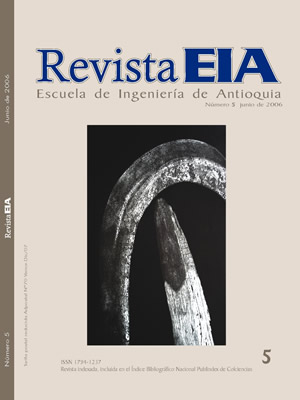EVALUACIÓN DE LA RESISTENCIA DE UN AISLADO BACTERIANO NATIVO COMPATIBLE CON Pseudomona sp. AL INSECTICIDA LORSBAN 4 EC
EVALUACIÓN DE LA RESISTENCIA DE UN AISLADO BACTERIANO NATIVO COMPATIBLE CON Pseudomona sp. AL INSECTICIDA LORSBAN 4 EC


This work is licensed under a Creative Commons Attribution-NonCommercial-NoDerivatives 4.0 International License.
Copyright statement
The authors exclusively assign to the Universidad EIA, with the power to assign to third parties, all the exploitation rights that derive from the works that are accepted for publication in the Revista EIA, as well as in any product derived from it and, in in particular, those of reproduction, distribution, public communication (including interactive making available) and transformation (including adaptation, modification and, where appropriate, translation), for all types of exploitation (by way of example and not limitation : in paper, electronic, online, computer or audiovisual format, as well as in any other format, even for promotional or advertising purposes and / or for the production of derivative products), for a worldwide territorial scope and for the entire duration of the rights provided for in the current published text of the Intellectual Property Law. This assignment will be made by the authors without the right to any type of remuneration or compensation.
Consequently, the author may not publish or disseminate the works that are selected for publication in the Revista EIA, neither totally nor partially, nor authorize their publication to third parties, without the prior express authorization, requested and granted in writing, from the Univeridad EIA.
Show authors biography
Se evaluó la resistencia de un aislado bacteriano compatible con Pseudomona sp. frente al insecticida Lorsban 4EC (ingrediente activo Chlorpyrifos) a escala de laboratorio. El aislado bacteriano se obtuvo a partir de un suelo del Oriente Antioqueño sometido a la aplicación del insecticida para el cultivo de pastos.Al suelo se le analizaron los principales factores que afectan la movilidad y adsorción del insecticida en él, se obtuvieron como resultados un porcentaje alto de materia orgánica, elementos mayores y menores así como media a alta capacidad de intercambio catiónico, lo que facilita la adsorción del plaguicida en su fracción coloidal de la micela orgánica e inorgánica. La textura franco arenosa del suelo genera buena aireación, que favorece los procesos de volatilización y degradación del plaguicida. El aislado bacteriano se expuso a diferentes concentraciones del insecticida (480 ppm, 4.800 ppm, 24.000 ppm y 48.000 ppm), evaluando de esta manera el efecto del agente sobre la población bacteriana. Según los resultados de los ensayos, la bacteria nativa compatible con Pseudomona sp. es resistente al insecticida con las concentraciones estudiadas y puede poseer la capacidad de degradar el insecticida.
Abstract: The resistance of an isolated bacterial culture compatible with Pseudomona sp. to the insecticide Lorsban 4 EC (active ingredient Chlorpyrifos) was evaluated at laboratory scale. The bacterial culture was isolated from a soil sample obtained in East Antioquia that was exposed to the application of the insecticide which is used in grass culture.The principal factors that affect the mobility and adsorption of insecticides in soil were analyzed. The results showed a high percentage of organic matter, and macro and micronutrients as well as medium to high cationic capacity of exchange, which facilitates the adsorption of the pesticide in the colloidal fraction of organic and inorganic fraction. The sandy texture of the soil generates good aeration that favors the processes of volatilization and degradation of the pesticide. Isolated bacterial culture was exposed to different concentrations of the insecticide (480, 4,800, 24,000 and 48,000 ppm), to evaluate the effect of the agent on the bacterial population. According to the results of the tests, the native isolated bacterium compatible with Pseudomona sp. is resistant to the insecticide conentrations studied and possibly has the capacity to degrade the Lorsban 4 EC.
Article visits 260 | PDF visits 185
